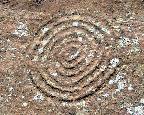
Who built the Great Medicine Wheels?
The Medicine Wheels in North America were built by the ancient Plains Indians,
nomadic tribes including the Sioux (Lakota, Dakota, Nakota),
Cheyenne, Crow, Blackfoot, Arapaho, Cree, Shoshoni, Comanche, and Pawnee.
Because they followed herds of buffalo and deer, they
were typically on the move most of the year.
At one time the Plains Indians occupied all of central North America,
from the North Saskatchewan River, in Canada,
to Texas, and from the valleys of the Mississippi and the Missouri to the foot of the Rockies.
Since they rarely stayed in one place, they did not need to build
permanent structures out of stone.
Thus architectural evidence of the ancient plains Indians
is almost non-existent.
Along with the lack of permanent buildings, they did not have
a written language. Their lore was passsed down in stories told through generations.
Even though they left no books to guide us, much of their story can
be gleaned in their art and artifacts.
Many of these objects reflect their fascination and respect for the Sun
and sky.
They looked at the heavens with wonder and awe just as we continue
to do today.
It appears these ancient Plains Indians were deeply connected to their environment and their mythology
is rich with celestial themes.
|
When were the Medicine Wheels built?
Medicine Wheels vary in age by centuries.
The current Bighorn Medicine Wheel in Wyoming is thought to be about 200 years
old, thus still fairly "new." However, there is some evidence that the wheel
existed for much longer than that, and that the current wheel is only the
last example of a wheel at Bighorn.
The Moose Mountain wheel in Saskatchewan is thought to be about 2000 years old,
thus built around the time of Christ. Moose Mountain is so similar to Bighorn
that some believe it was the model for the younger wheel.
The oldest wheel known is in
Majorville Canada. Archaeologists have set its age at 5000 years,
around the time of the Great pyramids of Egypt.
There is some evidence that some of the older
wheels have been adjusted over the centuries to correct for the shift in
alignment of the solstice.

|

